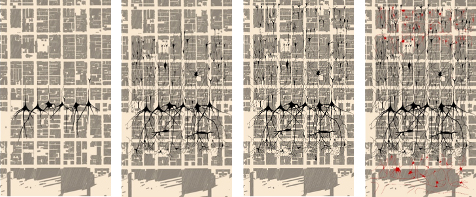Networks
Nan Li, Jiaqi Mo, Thomas Tse, Lingas Tran
The event of coronavirus and the global climate change crisis has urged us to rethink the role of design and designer in the current predicament and how we imagine moving forward in times of uncertainty. Triggered by ruined by design, we are proposing a loose network system that integrates with the existing Melbourne urban fabric to make it a more interactive, more accessible, and more adaptable volumetric city.
Cities are not static entities, instead they are living systems that can grow and adapt by themselves. This nerve system image drawn by Camilo Golgi (1875) is the starting point of our thinking. The image illustrates the paths of nerves in the brain structure are highly connected. As a system, we were inspired by its adaptability: in the human brain, the more we use the path of nerves, the thicker this path will be; otherwise, the less we use, the thinner it will be. The neurons can intermittently change their connections in between to form a complex but loose network. So that constantly, the system is reshaping itself to adjust to our needs.
If we rethink our current city as a system, clearly it doesn't work very well as it’s rigid and it failed to respond to unexpected disruptions like the pandemic. The proposed loose networks aim to dissolve the rigidness of our existing city by creating a volumetric system, both underground and above ground, to facilitate connectivity and accessibility at different levels.
The loose networks constantly expand or contract to adapt to various situations over time. Some may stay, but the networks will never be the same. The continuum of changing brings another dimension for people to experience the city – time. In the 4D city, walking will have much more fun. The journey in never-the-same networks will be full of unexpected surprises.
The living system thus can encourage urban slippages, where places are loosely defined and the programs are highly flexible and constantly adapting to different needs by the time changing. The slippages enable and foster bonding and bridging social capital, particularly in a time when isolation and physical distancing has had significant impacts both here in the communities of Melbourne and all over the world.
Fig 1. Translation of Camillo Golgi's nerve diagram to Hoddle grid of Melbourne CBD and the growth of networks.
The City of Networks is found in the land of the down under on volcanic plains that stretch west, and is bounded by grassland and rolling hills. The streets are tube like cables that stretch endlessly wrapping itself in and around rising glass towers as high as the sunny sky. The paths and connections are formed in every direction – to each building, floor, person and place. The streets are sometimes sandy, or sometimes like a park where the earth is cool and the grass is soft to touch. You can discover many different types of trees and birdwatch above tree tops on transparent glass floors that make you feel like you’re floating. The paths in the city shift and transform, they become narrow and shift to the wind, expands in the heat and grows in the spring time, but some of the streets do remain the same so you can always find your way home.
The City of Networks can be confusing at times, the street is always filled with excitement and there are countless numbers of people from distant cities that bring many stories and delicious foods. On an ordinary day the corner of the street leads to a café where people sit and read the newspaper and discuss important matters and then to a market where people dance and into a restaurant where people celebrate food and then quietly slipping away into a laneway where people meet to sip on martinis. The people who live in the glass towers in the city of networks anticipates the changes each season, particularly when the birds return and the flowers begin to bloom again, so that they can once again rediscover the city.


